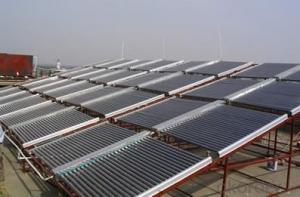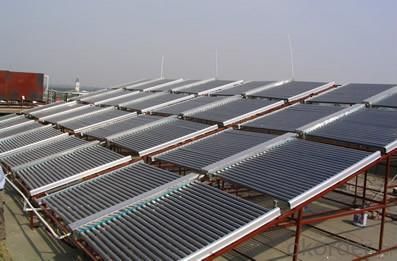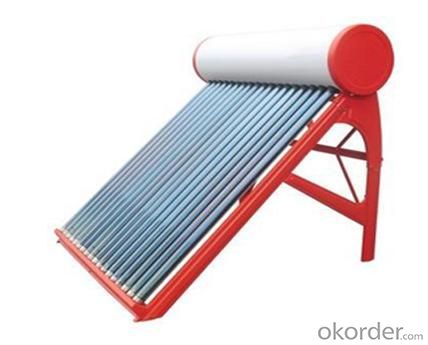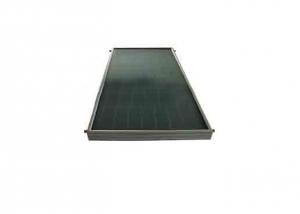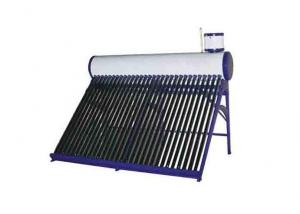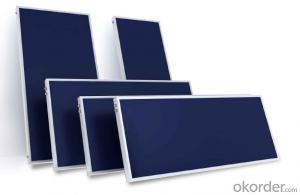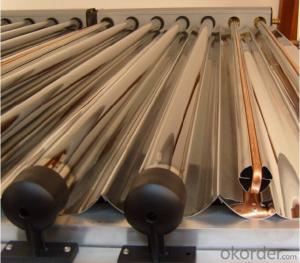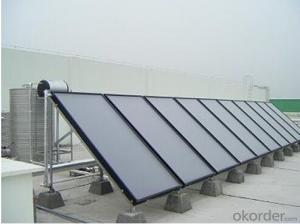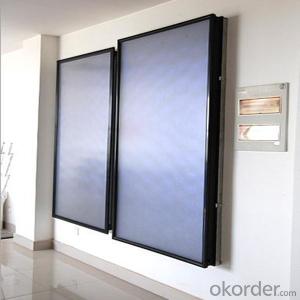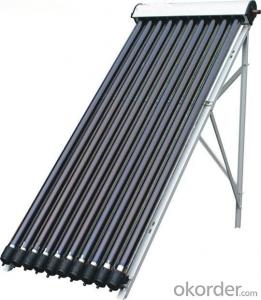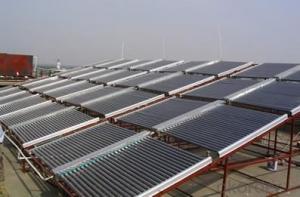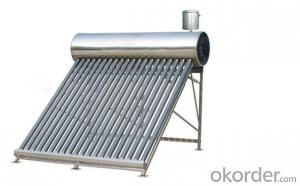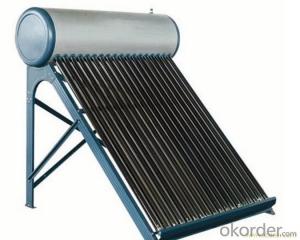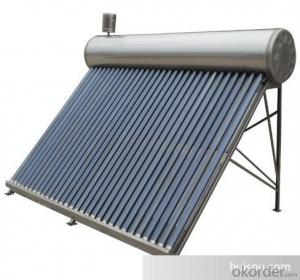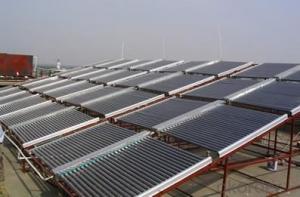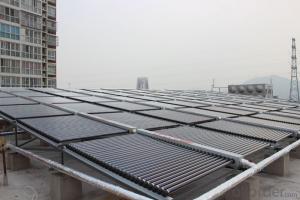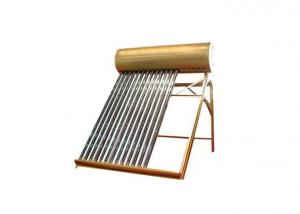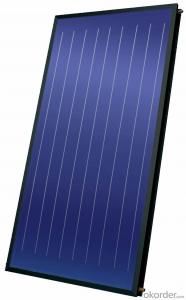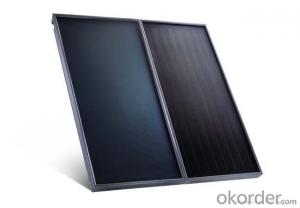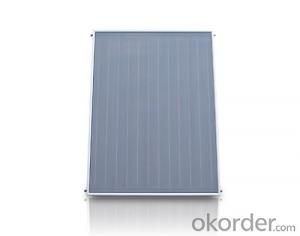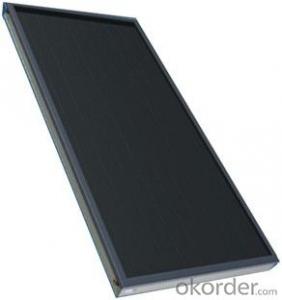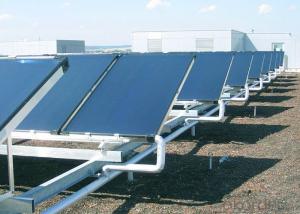Evacuated Tube Solar Collectors Price 2024 New Design Heat Pipe Solar Water Heater System
- Loading Port:
- China main port
- Payment Terms:
- TT OR LC
- Min Order Qty:
- 1 set
- Supply Capability:
- 6000 set/month
OKorder Service Pledge
OKorder Financial Service
You Might Also Like
Introduction of Non-Pressure Solar Water Heater:
Non-pressure Solar Heater is one of the most economical solar water heating device with pretty high efficiency at the same time. It consists of hot water storage tank, solar vacuum tubes with mouth plug in storage tank, and bracket supporting tank and tubes.When cold water in evacuated tubes is heated with solar irradiation, as the specific gravities of hot water and cold water are different, hotter water goes upward to storage tank and colder water goes downward to glass tubes. through this continuous circulation, the cold water in storage tank will be gradually heated till sunset.
Specialty:
1. High thermal performance and working temperature: the heat exchanging rate even in winter can up above 55%.
2. Heat collecting efficiency is at least 20% above common solar systems.
3. Work in all day and all season: no matter any corner of the world, this system can work well even -40℃ to avoid the tube freezing problem.
4. Reliability: No water following through the tube, so water scale can not generate and tube cracks could be avoided, the system still can keep working even with some damaged tubes.
5. It can connect with water tap and work automatically with pressure0.6Mpa, bring enjoyable washing experience.
6. Safety: P/T valve would release pressure and temperature to protect tank..
Technical Specification:
1. Outer tank material: SUS304 stainless steel or powder coated color steel
2. Inner tank material: 1.2mm thick SUS304 food grade stainless steel ( Optional material SUS316L)
3. Vacuum tube material: borosilicate glass 3.3; AL-SS-CU absorb coating, with copper heat pipe inside
4. Frame material: 1.2mm thickness stainless steel
5. Insulation material: 55mm thickness polyurethane
6. Suitable for mains pressure water(up to 8 bar/116psi)
7. Easy plug-in installation
8. Install the T/P valve on the pressurized tank
9. Seal material: Stabilized High Temperature Silicon
Outer tank material: SUS304 stainless steel or powder coated color steel
Inner tank material: 1.2mm thick SUS304 food grade stainless steel ( Optional material SUS316L)
Vacuum tube material: borosilicate glass 3.3; AL-SS-CU absorb coating, with copper heat pipe inside
Frame material: 1.2mm thickness stainless steel
Insulation material: 55mm thickness polyurethane
Suitable for mains pressure water(up to 8 bar/116psi)
Easy plug-in installation
Install the T/P valve on the pressurized tank
Seal material: Stabilized High Temperature Silicon
19. Vacuum Tube | 20. Size (mm) | 21. Φ47*1500 / Φ58*1800 / Φ70*2100 | |||||
22. Tube (pcs) | 23. 10 / 12 / 15 / 18 / 20 / 22 / 24 / 30 / 36 / 42 | ||||||
24. Material | 25. Borosilicate 3.3 glass, magnetron spluttering selective coating | ||||||
26. Coating | 27. Single-target AL-N/AL or Three-target AL/N-Cu-SS | ||||||
28. Water Tank | 29. Capacity | 30. 80L ~ 500L for hot water storage tank | |||||
31. Inner tank | 32. Food-grade stainless steel SUS304-2B / SUS316 | ||||||
33. Insulation | 34. High-density polyurethane foam with 70~80 hour heat preservation | ||||||
35. Tank shell | 36. Food-grade stainless steel SUS304-2B | ||||||
37. Bracket | 38. Shaped strong aluminum alloy structure adaptable for flat or slope roof | ||||||
39. Accessories | 40. Anti-aging silicon seals, Dustproof seals, Air-vent cap, Stainless screws | ||||||
41. Auxiliary Devices | 42. Assistant tank, Intelligent controller, Electrical heater, Magnesium anodes | ||||||
43. Tilt Angle | 44. 25 ~ 50° | ||||||
45. Water Output | 46. 45 - 95°C | ||||||
47. Hail Resistance | 48. Φ25mm diameter | ||||||
49. Model Number | 50. Solar Vacuum Tube | 51. Tank 52. Liter | 53. System 54. Liter | 55. Container Loading Qty /sets | |||
56. Size /mm | 57. Qty /pcs | 58. 20GP | 59. 40GP | 60. 40HQ | |||
61. VNS-58SA12-100 | 62. Φ58*1800 | 63. 12 | 64. 100 | 65. 132 | 66. 58 | 67. 119 | 68. 140 |
69. VNS-58SA15-130 | 70. 15 | 71. 130 | 72. 170 | 73. 54 | 74. 108 | 75. 131 | |
76. VNS-58SA18-150 | 77. 18 | 78. 150 | 79. 198 | 80. 43 | 81. 86 | 82. 105 | |
83. VNS-58SA20-170 | 84. 20 | 85. 170 | 86. 223 | 87. 40 | 88. 80 | 89. 97 | |
VNS-58SA24-200 | 24 | 200 | 263 | 35 | 70 | 85 | |
VNS-58SA30-250 | 30 | 250 | 329 | 28 | 56 | 68 | |
VNS-58SA36-300 | 36 | 300 | 395 | 23 | 47 | 57 | |
Product Show
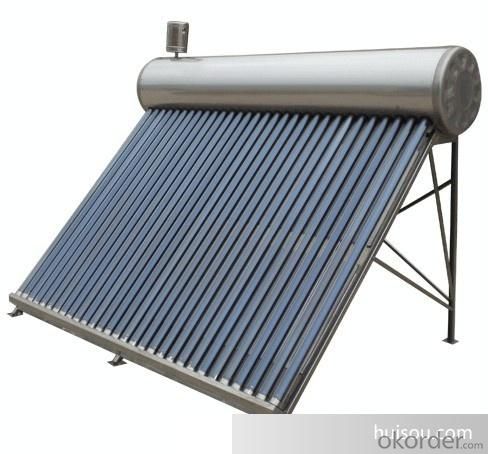
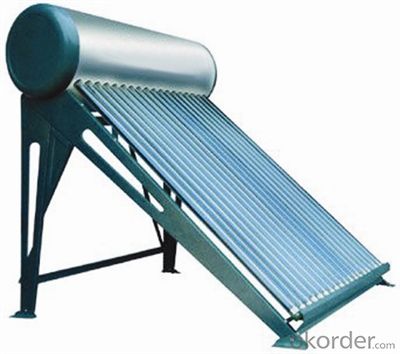
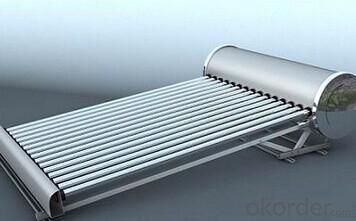
Our Services
1. OEM service
2. Warranty: 5 years
3. Considerable after sale service
Color steel Compact pressure Thermal solar heater
FAQ:
1. What’s the delivery time?
10 days after receiving deposit.
2. How long is the warranty?
5 years for whole system, 1 year for accessory
3. What’s your production capacity?
6000sets/month
4. What’s the MOQ?
1 set.
5. What’s your payment term?
Container: 30% T/T in advance for deposit, 70% T/T before shipment for fist order.
70% T/T after seeing copy of B/L from second order
Sample: 100% T/T in advance
Other choices: L/C at sight.
6. What certifications do you have?
CE, SOLAR KEYMARK, SRCC and etc.
- Q: Can solar collectors be used for heating casinos?
- Certainly, heating casinos using solar collectors is possible. Solar collectors, also referred to as solar thermal systems, have the ability to capture the sun's energy and convert it into heat. This heat can serve various purposes, such as heating water, providing space heating, and even warming up large establishments like casinos. To utilize solar collectors for heating purposes, they can be installed on the casino's rooftops or nearby areas. This captured heat can then supplement or potentially replace traditional heating systems. By doing so, the reliance on fossil fuels can be significantly reduced, resulting in lower energy costs for the casino. The design and size of the solar thermal system would depend on the specific heating requirements of the casino. Factors like climate, building size, and the desired temperature would determine the quantity and dimensions of the solar collectors needed. Furthermore, solar thermal systems can be integrated with existing heating systems, allowing for a hybrid approach that combines solar energy with conventional heating methods. This ensures a consistent and reliable heat supply, even during periods of low sunlight. In conclusion, solar collectors can undoubtedly be used to heat casinos, offering a sustainable and cost-effective solution that diminishes the environmental impact of heating operations while simultaneously decreasing energy expenses.
- Q: How do solar collectors compare to traditional heating systems in terms of efficiency?
- Solar collectors are generally more efficient than traditional heating systems. They harness the power of the sun to directly convert sunlight into heat energy, which eliminates the need for fuel consumption. Traditional heating systems, on the other hand, rely on burning fossil fuels, which leads to energy loss and environmental pollution. Additionally, solar collectors can be combined with other energy-efficient technologies, such as heat pumps, to further enhance their efficiency. Overall, solar collectors offer a more sustainable and efficient solution for heating needs.
- Q: Can solar collectors be used in nuclear power plants?
- Solar collectors cannot be directly used in nuclear power plants. Nuclear power plants generate electricity by harnessing the energy from nuclear reactions, specifically nuclear fission. This process involves splitting atoms to release energy, which is then converted into electricity. Solar collectors, on the other hand, rely on the conversion of sunlight into electricity using photovoltaic cells. While both solar collectors and nuclear power plants are alternative sources of energy, they operate on different principles and technologies. Solar collectors are dependent on sunlight, making them suitable for areas with abundant sunshine. Nuclear power plants, on the other hand, can generate electricity continuously, regardless of weather conditions or time of day. However, it is worth mentioning that solar energy can be complementary to nuclear power plants. Solar panels can be installed in nuclear power plant facilities to provide auxiliary power for non-essential systems, such as lighting, ventilation, and monitoring. This can help reduce the overall energy consumption of the plant and increase its efficiency. Additionally, solar energy can be used in the heating and cooling processes of nuclear power plants, reducing the reliance on fossil fuels or other non-renewable energy sources. In summary, solar collectors cannot be used directly in nuclear power plants to generate electricity. However, solar energy can be utilized in ancillary systems, as well as in the heating and cooling processes, to increase the overall efficiency and sustainability of nuclear power plants.
- Q: Are there any limitations on the slope or angle of solar collectors?
- Yes, there are limitations on the slope or angle of solar collectors. The optimal angle for solar collectors varies depending on the geographical location. However, as a general guideline, solar collectors are typically installed at an angle equal to or close to the latitude of the installation site to maximize energy absorption. Steeper or shallower angles may result in reduced efficiency as the collectors may not receive optimal sunlight. Additionally, extreme slopes or angles may pose structural challenges and increase the risk of damage from wind or other weather conditions. Therefore, while there are some limitations, proper orientation and angle selection can significantly enhance the performance of solar collectors.
- Q: Can solar collectors be used in areas with limited access to certification bodies?
- Yes, solar collectors can be used in areas with limited access to certification bodies. While certifications can provide reassurance of quality and performance, they are not mandatory for the operation and functionality of solar collectors. Solar collectors can still provide renewable energy benefits and contribute to reducing reliance on traditional energy sources in areas without certification bodies.
- Q: Can solar collectors be installed on rooftops?
- Yes, solar collectors can be installed on rooftops. In fact, rooftops are an ideal location for solar collectors as they receive direct sunlight and are often unobstructed by shade. Rooftop solar installations are becoming increasingly common as they allow for efficient use of space and can significantly reduce energy costs for households and businesses.
- Q: Can solar collectors be used in public transportation?
- Public transportation can indeed utilize solar collectors. Known also as solar panels or photovoltaic (PV) modules, solar collectors are devices that convert sunlight into electricity. They can be installed on the roofs or surfaces of buses, trains, or other forms of public transportation to generate clean and renewable energy. The use of solar collectors in public transportation brings several advantages. Firstly, solar energy aids in reducing reliance on fossil fuels, which greatly contribute to air pollution and climate change. With the ability to generate electricity from the sun, public transportation becomes more sustainable and environmentally friendly. Furthermore, solar collectors help decrease operating costs for public transportation systems. The electricity generated from solar panels can power various onboard systems such as lighting, air conditioning, and electronic devices. This reduces dependence on the grid and lowers energy expenses. Additionally, solar collectors extend the range and efficiency of electric buses or trains. By providing a continuous energy source, solar panels recharge the batteries of electric vehicles, enabling them to operate for longer periods without frequent recharging or the risk of power depletion. Moreover, solar collectors can be utilized to power charging stations for electric vehicles used in public transportation. This infrastructure facilitates the adoption of electric buses or trains by offering convenient and sustainable charging options. It is important to consider that the effectiveness of solar collectors in public transportation may vary depending on factors like sunlight availability, solar panel size and efficiency, and the energy requirements of the specific transportation system. However, with advancements in solar technology and the growing emphasis on renewable energy, integrating solar collectors into public transportation presents a viable and beneficial option for reducing emissions, cutting costs, and promoting sustainable mobility.
- Q: Can solar collectors be used for generating electricity on bicycles?
- No, solar collectors cannot be directly used for generating electricity on bicycles as they require a stationary position and a larger surface area to efficiently collect sunlight. However, solar panels can be used to charge batteries that can then power electric bicycles.
- Q: Can solar collectors be used in power plants?
- Yes, solar collectors can be used in power plants. They are commonly employed in solar thermal power plants to harness the sun's energy and convert it into electricity. Solar collectors, such as parabolic troughs or solar towers, are used to concentrate the sunlight onto a heat transfer fluid, which then produces steam to drive a turbine and generate electricity. Solar collectors are a sustainable and renewable energy solution for power plants.
- Q: Can solar collectors be used for generating electricity on hospitals?
- Indeed, electricity generation on hospitals can be achieved through the use of solar collectors. Solar collectors, alternatively referred to as solar panels or photovoltaic (PV) panels, are devices that convert sunlight into electrical energy. These panels can be installed on the rooftops or any available open space of hospital buildings to harness solar power and generate electricity. The utilization of solar collectors for electricity generation on hospitals presents several advantages. Firstly, it diminishes reliance on conventional electricity sources like fossil fuels, which are not only expensive but also contribute to air pollution and climate change. By harnessing solar energy, hospitals can significantly reduce their carbon footprint and contribute to a cleaner and more sustainable environment. Secondly, solar collectors provide a reliable and consistent source of electricity. Hospitals necessitate an uninterrupted and constant power supply to operate critical medical equipment, lighting, HVAC systems, and other vital services. Solar panels can generate electricity even on overcast days, ensuring a dependable power source for hospitals. Furthermore, the installation of solar collectors on hospitals can also result in energy cost reduction. Although the initial investment for installing solar panels may be higher, they possess a long lifespan and require minimal maintenance. Over time, hospitals can save a substantial amount of money on their electricity bills, enabling them to allocate more resources to patient care and other essential services. In addition to electricity generation, solar collectors can also be employed for water heating in hospitals. Solar thermal collectors can capture the sun's heat and transfer it to water, providing hot water for various hospital needs such as bathing, cleaning, and sterilization. Overall, solar collectors offer a practical and sustainable solution for electricity generation on hospitals. Not only do they decrease reliance on fossil fuels and contribute to environmental preservation, but they also provide long-term cost savings and a reliable power source for crucial hospital operations.
Send your message to us
Evacuated Tube Solar Collectors Price 2024 New Design Heat Pipe Solar Water Heater System
- Loading Port:
- China main port
- Payment Terms:
- TT OR LC
- Min Order Qty:
- 1 set
- Supply Capability:
- 6000 set/month
OKorder Service Pledge
OKorder Financial Service
Similar products
Hot products
Hot Searches
Related keywords
